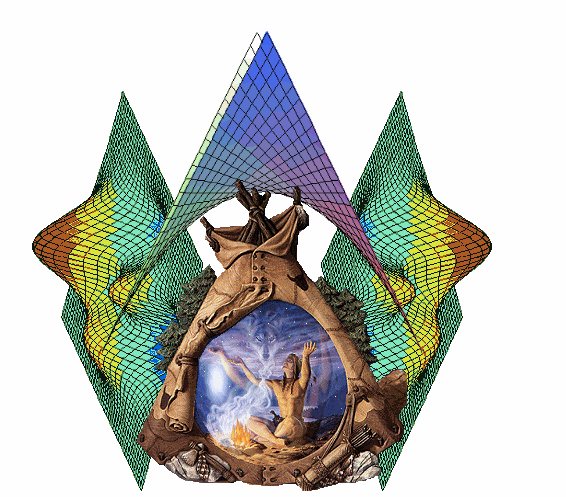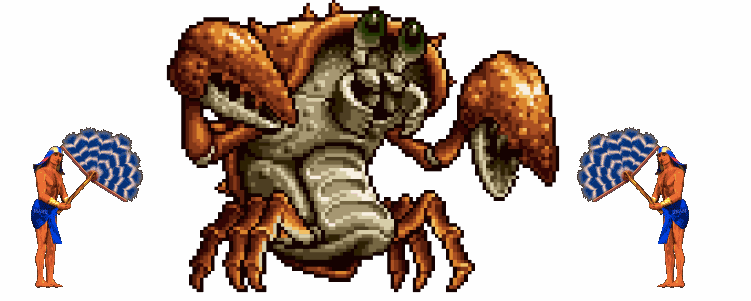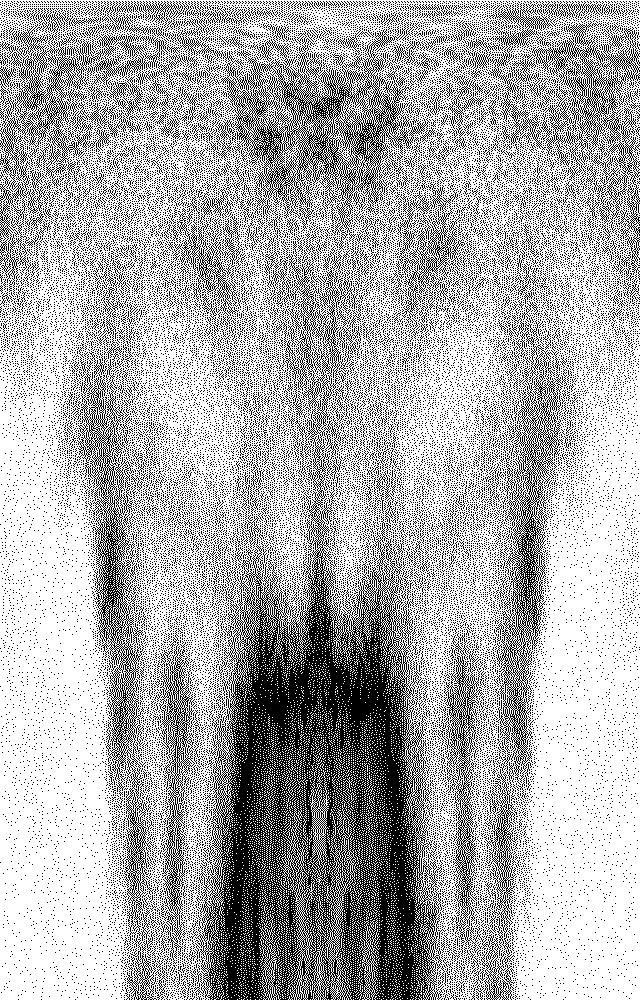Art World
A Brief History of Animated GIF Art, Part Two
From 2006 to 2010, artists posted GIF art en masse to collaborative blog platforms.

From 2006 to 2010, artists posted GIF art en masse to collaborative blog platforms.

Paddy Johnson

Welcome to part two of this brief journey through the rich history of one of the newest and most popular art forms, the animated GIF. To read the first part, “The Early Years: 1997–2008,” click here.
GROUP BLOGS, SURF CLUBS, AND THE BEGINNING OF SOCIAL NETWORKING
The period from 2006 to 2010 was marked by the rise of self-started social networks. Artists were sharing GIFs on Myspace before many migrated to their own collaboratively run blogs. These sites hosted an enormous number of found and self-made GIFs, and tended to be male-dominated. A few highlights from the golden era of GIF art blogs below.

Sally McKay, X-mas GIF (circa 2003).
Digital Media Tree, 2000–present
This consortium of four blogs built on custom software by Jim Bassett includes Bill Schwartz, Sally McKay and Lorna Mills, Tom Moody, and Pst. Only two of the artists focused on New Media and GIFs, the duo of McKay and Mills, and Moody—and he has since moved his blog to WordPress. All that said, Digital Media Tree was a much needed New Media presence in the early blogging scene with archives dating back to 2003, when the blog was mostly image-less.
According to Mills, it was McKay’s interest in animated GIFs that originally influenced her and Moody, both of whom went on to work extensively with the format. McKay’s own GIF production has slowed, but there are vast archives to click through on her page, Mills’, and Moody’s, as well as a paper that McKay wrote in 2009, which closely examines the animated GIF called, “The Affect of Animated GIFs (Tom Moody, Petra Cortright, Lorna Mills).” The essay is required reading for anyone interested in the medium.
Computers Club, 2007–present
Computers Club founder Krist Wood describes it as a “digital sculpture,” a composite artwork shaped by the identities of its contributors. All members have been invited by Wood, and new members are rarely added. Basically, it’s a collaborative art blog with a green rotating splash page and no visible publishing dates. According to the members page, Computers Club has 19 members.
Unsurprisingly, the blog has hosted seemingly countless GIFs over the seven years it’s been running. Recent images tend to be supersized, but they already tended to be large back when the site launched. Artists usually post their own work.
The Computers Club Drawing Society works differently. Artists are encouraged to apply for membership and invitations are periodically given out. There is a communal set of digital drawing tools members can use to make images, and they are shared on a public page. Most posts draw one or two comments from artists, typically expressing appreciation for the work.
Computers Club Members: Sage Keeler, Petra Cortright, Alexandria McCrosky, Daniel Williams, Matthew Wrath, Laura Brothers, Robert Lorayn, Krist Wood, Rene Abythe, Nicolas Sassoon, Sara Ludy, Duncan Malashock, Travess Smalley, Rafael Rozendaal, Alexander Peverett, Kathleen Daniel, Sabrina Ratte, Elna Frederick, Angelo Plessas, and Wyne Veen.

Image by Tim B.
Via dump.fm Hall of Fame.
Dump.fm Hall of Fame, 2009–present
Dump.fm is the first site to bring real-time image chat to the Internet and may well be co-founder Ryder Ripps’s greatest contribution to the web. Of particular interest is an early image dumping style that emerged circa 2009–10 that many dumpers describe as “altars”—a symmetrical arrangements of three or more images in a single dump, or post.

Image by Tom Moody.
Via dump.fm Hall of Fame.
The form’s popularity persists to this day. It’s a natural result of dump.fm’s design, which creates a horizontal line that can accommodate “sentences” of words, photos, GIFs, and other elements.

Image by Andrej Ujhazy.
Via dump.fm.
Whatever the case, I’ve highlighted three GIF arrangements from the dump.fm Hall of Fame that I’m interested in for their relationship to Haim Steinbach’s visually melodic shelves displaying pop culture relics. But whereas Steinbach’s selections are carefully arranged and often inscrutable, these altars use a similar generic format for a very different purpose: high-speed conversation. The end results are often just as bewildering as Steinbach’s juxtapositions of seemingly unrelated objects.





Detail of Marisa Olson, 102 Dalmatians (2010).
Via Nasty Nets.
Nasty Nets, 2006–2012
Founded in 2006 to help make up for the absence of images on social bookmarking devices like Delicious, Nasty Nets was an invite-only, collaboratively run blog described as a “surf club.” While pretty much anything could be posted on the blog, members of the website tended to focus on elements of the web typically forgotten or disregarded. That meant a lot of GIFs, though they weren’t always images that were intended as art. For the most part the site was used to develop ideas, not launch new artworks (though that did happen from time to time).
The post highlighted here was among the last updates before Nasty Nets was hacked (the blog is now permanently archived on Rhizome) and reflected the common practice of posting images that directly referenced pop culture in some way. Marisa Olson provides an update to 101 Dalmatians while referencing the 2000 Disney sequel, 102 Dalmatians. Her post, like many on the site, isn’t the kind of art that requires diligent viewing, but it’s not quite entertainment either. It’s a little like looking at an athlete’s exercise routine as a means of understanding how they perform in competition; posting keeps an artist’s eye and mind fit.

Via Spirit Surfers.
Spirit Surfers, 2009–present
Unlike Nasty Nets, Spirit Surfers frames itself as an art project, with each new bit of content on the site contributing to the ongoing project. Posts are tagged as “boons,” the bounty from searching, or “wakes,” the precursor to the search. GIFs are everywhere.
Notably, many of the GIFs posted on the site suggest a spiritual presence, as if the act of surfing alone where a means to reach other, more intangible spaces. That’s not an accident. Founder Kevin Bewersdorf began the blog while maintaining the spiritual practice of embracing web mediocrity. Bloggers refer to themselves as “infomonks” and the blog is known among users as “the monastery.” The movement of the GIF, which loops continuously, seems like a perfect metaphor for the repetitiveness of monastic life and may explain their ubiquity on the site.
Double Happiness, Loshadka, etc.
Dump.fm, Nasty Nets, and Spirit Surfers weren’t the only group blogs, but they were arguably the most dominant in the 2006–10 period under consideration here. Double Happiness, a site run by NYU students, became known for embracing advertising (especially for fast food), porn, and virtually any oversize image. Tom Moody aptly described the site as a scroll bar workout. Loshadka, another group blog distinguished by its use of unique image tags and large amounts of original material, also made waves in this period.
Ultimately, the lifespan of most surf clubs was less than five years. Networked blogs like Tumblr took their place, leaving these projects and their GIFs without updates. Short of being hacked or hosting your work on a site that goes out of business, a lack of new posts may be one of the few forms of closure online.
Read part one of Paddy Johnson’s brief history of animated GIF art here, and stay tuned for the next installment, which will address the rise of Tumblr, animated GIF group shows, the Wrong Biennial, and more.